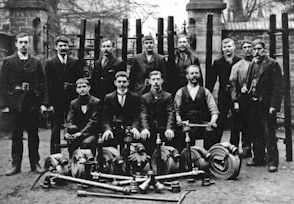|
|
| Home Topics Memorials Miscellany Transcripts References Family History Glossary Latest Beeston Blog About us | Site Search |
Text & Photographs |
"
|
| Dear Sir I have had a great deal of conversation with your late workmen which are now out on strike and from what I can gather from this conversation they would nearly all come back to work again if you sent for them. I asked them if they would go and work with non-society men and they said they did not mind working with their own men but not with strangers which was in, and from what several of the men say it will be a long time before they come out again. I think it would be wise of you Mr Pollard to send for all your men back again, it looks to me as if they are only waiting for you to send for them. I will let you know more if I can get to hear anything. Believe me, Yours truly, A Beeston Tradesman |
In 1899 Arthur Pollard was paid £5 a week as manager, 10/- less than Arthur Meakin the draughtsman. In 1900 his situation changed dramatically. Not long after his marriage and the birth of his first son, John, in December 1899, an agreement was drawn up between John snr and Arthur. The terms were - that Arthur should continue to be paid his salary of £250 per year, but also take 50% of the profits30. His income increased many times. Balance sheets show that in 1901 he received £2066, in addition to the £250 salary and in some later years his share of the profits was over £3,000. The 1900 Agreement, between father and son was accompanied by a "Statement of Affairs", which included a valuation of the lace machines and appliances at £10,600; there were then 30 machines.
The Statement of Affairs also included a list of debtors. Of the 12 firms owing Pollards over £50 in 1900, most were lace manufacturers (merchants) in the lace market (Appendix 3). Pollardís marketed mainly through the lace market and never finished31 their lace32. Another list of customers33, probably of a similar date as it included most of the names in the Statement of Affairs, also named Yena Laces, U.S.A.; Maison Bouttez, Calais; J.H. Smith, Calais; and Michel, Zurich. It seems therefore that lace was exported directly from the factory. Although the major part of Nottingham lace production was for export, the export business was generally of finished lace, and was by the merchants in the Lace Market; but there was also direct export of unfinished fine lace from some factories. On one occasion John Pollard jnr remembered going with his father to Calais and "Father had in his poacherís pocket a 12yd 154" wide piece of lace. This was handed to ĎCalais Smithí, the yarn agent, on the ferry gangway, and so did not go through customs." He remembered a gendarme standing by, pretending not to see34.
An early (1879) postcard from J & J Kirk, of Commerce Square in the lace market to John Pollard, gives a feeling for the relationship between the merchant manufacturers and the lace makers. "Mr Kirk has seen the spotted quillings35 and likes the make, but cannot do anything until he gets the particulars: would be glad to see you tomorrow morning". The speed of the post is striking, as also is the peremptory tone. No doubt John Pollard, the factory master, or his representative, reported at the lace market with the sample. John Pollard jnr went to the Lace Market as a boy, with his father, and saw lace makers queuing up on each step of manufacturers such as Vickers & Hine36. Still more direct was a postcard from France in 1913, saying simply "Gentlemen, where is my order". Perhaps this was the lace delivered in person to Calais Smith!
The Nottingham lace manufacturers37 did not always understand the technology and limitations of the machinery, coming, as many did, from very different backgrounds to the lace makers. Some of the larger firms, such as Jacoby and Co., Stiebel Kaufman and Simon May, all amongst the Pollardsí customers, were founded by German Jews and had an international outlook, but perhaps little understanding of how long it took to set out a lace machine for a new pattern.
This period also saw the affair of Zion City Lace Industries; a curious business with special relevance to Beeston and the Pollards. Zion City, near Chicago, was founded by a religious charlatan, Alexander John Dowie. One of many similar exhortations in his Zion newspaper, The Coming City captures the flavour: "Fellow Christians, if your heart is in Zion, then let you investments be in Zion also, and God will certainly bless you and prosper you spiritually, physically and financially".
Dowie recruited Nottingham lace workers, including several from Beeston. His general manager of the lace factory, the industrial centrepiece of Zion City, was Samuel Stevenson, who had formerly rented standings in Swiss Mills (possibly the Stevenson of Towle and Stevenson in the 1887 rental, although there were several brothers). There appeared in The Coming City, a photograph of Swiss Mills described as "Zion Lace Industries, Beeston Notts"; there were also many inside views, showing machines, draughting rooms, mending rooms etc. Unfortunately for our story and for our knowledge of the family factory, the inside views are not of Swiss Mills38 and the factory that is shown is not known as far as we are aware. Dowieís Zion lace factory, after employing the huge number of 3000 workers for a short period, soon failed, although lace making continued there by others, in some form.
John Pollard died in 1903. A local newspaper report39 said, perhaps exaggerating, that some 200 hands "followed their deceased master to his last resting place"40. The manufacturers with standings in Swiss Mills attended the funeral, as did representatives from Nottingham lace warehouses. Wreaths included one from the menders and winders and another from grandsons John and Walter, aged 4 and 3. John Pollardís membership of the Local Board, including the School Board and Highways Committee is mentioned. He was the only one of the Pollard factory owners to play a role in local politics. He instigated the building of Station Road, the new road from Middle Street direct to the station, of value to the town of course, but especially helpful to the factory for the the transport of coal41, cotton and lace, and speeding his and his workersí journeys to and from Nottingham.
1 Note by John Pollard jnr: his grandmother (John snrís wife) told him that she was sometimes woken by the noise of the machines, when they were operated too vigorously.
2 Family papers: receipts for quarterly payments - increasing from approximately £13 in 1873 to £17 in 1876. Robert Porter does not appear in the early factory deeds or in lace trade records.
3 We know that John Pollard owned the fitting shop in 1877 because in that year he increased its width to accommodate larger machines. Detailed invoices for the work, by Foster and Pearson, have survived in the family papers; it took from August until December and cost £400.
4 Early Swiss Mills deeds - seen by the author in the 1980s; they were then held by the Nottingham solicitors, Hunt, Dickens and Willatt.
5 S.M. p.166.
6 Mending: repairing holes in the lace. Jacking, usually "Jacking off"; stripping the ends of yarn from bobbins for re-use.
7 Threading: inserting the bobbins in the carriages - see Lace Machines page.
8 Family tradition was that he caught a chill after falling in a pond, but the cause of death on his death certificate is given as typhoid.
9 Racks: a measure of quantity of lace - for examples in use in pattern book on Lace page.
10 John Pollard in conversation with Sheila Mason.
11 A suggestion made by Sheila Mason.
12 This was piecework; in this case 9d was the price per rack of lace.
13 A letter to John Pollard from the union, dated 20 May 1878, shows the strike holding firm; copy of the letter provided by Sheila Mason.
14 An image has come down to us, initially told to our father, of John Pollard inspecting the progress of the Swiss Mills building, high on a ladder, calling down "more grout, more grout"; of little consequence but helping to bring him to life.
15 Told by John Pollard jnr to Sheila Mason.
16 Afamily story relates that the occupantís wife, Mrs Maltby, understandably objected to the factory rising up outside her window and knocked bricks off as they were laid; the solution was to buy the house - at her price. The deeds confirm that the shop was bought in 1886. Another story from our father is that, when the Methodist Church was about to be built opposite to, and earlier than, Swiss Mills, John Pollard insisted that it should be moved further back to allow for a wider road.
17 Turton described himself as "Lace designer and draughtsman" in the 1881 census, Meakin was "Draughtsman and Designer" in the Memorandum of Agreement mentioned in Footnote 18. Combination of the two jobs may have been usual in smaller firms.
18 Agreement of Service between Edwin Turton and John Pollard, September 12 1882 - copy of original provided by Sheila Mason. A similar 1895 Memorandum of Agreement between John Pollard and Arthur Meakin (family papers) was for three years and was twice renewed.
19 S.M. p.64.
20 George and Edwin were in different Turton households in the 1881 census, the former on Villa Street, the latter in Nottingham.
21 1881 census.
22 S.M. p. 181
23 1891 and 1901 censuses
24 We remember this outwork continuing into the 1950s; a specific memory is of our father carrying a huge bundle of unwrapped lace to a house somewhere off Wollaton Road.
25 S.M. p121.
26 John Pollard in conversation with Sheila Mason.
27 The Evening News, 21 August 1897.
28 John Pollard in conversation with Sheila Mason.
29 SM p.176: the "Amalgamated Society of Operative Lace Makers and Auxiliary Workers".
30 Agreement dated 22 June 1900: the agreement was drawn up by a Nottingham solicitor and included details of the way in which "Pollardís Factory" should be run - family papers
31 Finishing: the process of turning lace from the machine into fabric as used in clothing etc, by washing, starching, bleaching, scalloping etc.
32 Information from John Pollard jnr and S.M. p.259.
33 Hand written list, headed "Customers" compiled by John Pollard jnr from sources unknown to us.
34 John Pollard in conversation with Sheila Mason.
35 Quillings: narrow lace for edgings.
36 John Pollard in conversation with Sheila Mason.
37 see S.M. Chapter 4 for an account of the merchanting of lace.
38 Angel Row Library. The auther came across these photographs in the 1980s and assumed that they were of Swiss Mills c1900. He took copies, returned with some triumph to show his father, John Pollard jnr, who immediately said that they were not Pollardís Factory. They are indeed rather grand for Swiss Mills; closer inspection shows that the fenestration is unlike any there.
39 Newspaper cutting in family papers, source not known.
40 A 1947 newspaper interview with Arthur Pollard (see Footnote 6, Arthur & John Pollard chapter) indicated that the maximum labour force was about 120.
41 John Pollard jnr, in conversation with Sheila Mason remembered that in the early 1900s there were three or four loads of coal a day from Beeston Station to Swiss Mills and the Anglo. The only time coal ran short was when there was an unusual number of funerals, because the horses, stabled in Park Street, pulled both coal drays and hearses.
or - Click here to go back to the top
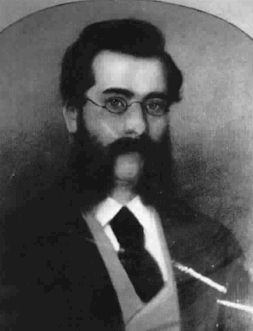 John Pollard -
John, like Thomas, had hand operated lace machines in an outbuilding of his house in Villa Street1, but in 1864, aged 25, he is
listed in a Nottinghamshire directory as a lace maker and machine holder in Dobsonís Mill in Cross Street. That is, he rented a standing or
standings (floor space for machines) from the factory owner and either owned or rented machines. He prospered and by the 1871 census had
moved to a substantial house in Middleton Street. Very early in the history of the firm he seems to have become the dominant partner.
John Pollard -
John, like Thomas, had hand operated lace machines in an outbuilding of his house in Villa Street1, but in 1864, aged 25, he is
listed in a Nottinghamshire directory as a lace maker and machine holder in Dobsonís Mill in Cross Street. That is, he rented a standing or
standings (floor space for machines) from the factory owner and either owned or rented machines. He prospered and by the 1871 census had
moved to a substantial house in Middleton Street. Very early in the history of the firm he seems to have become the dominant partner.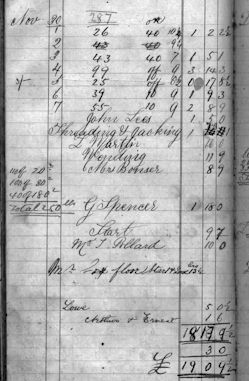
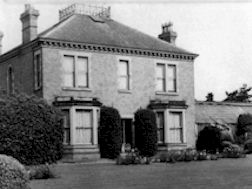 Some time between 1876 and the 1881 census, John built Cromwell House, a large house on a plot of several acres on Cyprus Avenue, then at the northern
edge of Beeston. Like many successful industrialists he moved away from his factory. A map of the time (
Some time between 1876 and the 1881 census, John built Cromwell House, a large house on a plot of several acres on Cyprus Avenue, then at the northern
edge of Beeston. Like many successful industrialists he moved away from his factory. A map of the time (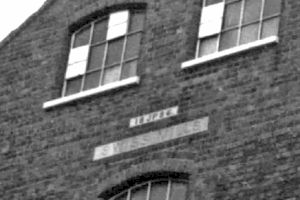 The new building was in a conspicuous position on Wollaton Road, with Johnís initials, the year and "Swiss Mills" high on the building, overlooking
the road. First the shell was built and roofed; then the building was completed floor by floor from the inside and we are told that when each floor was
finished the space was rented14. Swiss Mills, a plain, strictly functional building, was in striking contrast to the Victorian Gothic of the Anglo Scotian
Mills higher up Wollaton Road, built only a few years later - the difference reflecting the characters of their builders, the down to earth John Pollard
and the flamboyant Frank Wilkinson of Anglo Scotian Mills.
The new building was in a conspicuous position on Wollaton Road, with Johnís initials, the year and "Swiss Mills" high on the building, overlooking
the road. First the shell was built and roofed; then the building was completed floor by floor from the inside and we are told that when each floor was
finished the space was rented14. Swiss Mills, a plain, strictly functional building, was in striking contrast to the Victorian Gothic of the Anglo Scotian
Mills higher up Wollaton Road, built only a few years later - the difference reflecting the characters of their builders, the down to earth John Pollard
and the flamboyant Frank Wilkinson of Anglo Scotian Mills. Draughtsman could be "poached". A note (shown right) from an unknown apprentice to his (unknown) master gives a feeling for the intrigues that
occurred, although just what is suspected here is not obvious to us now.
Draughtsman could be "poached". A note (shown right) from an unknown apprentice to his (unknown) master gives a feeling for the intrigues that
occurred, although just what is suspected here is not obvious to us now.